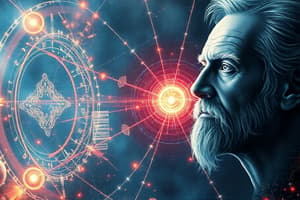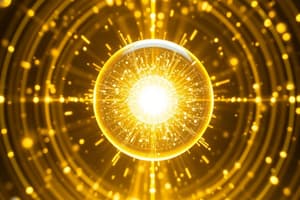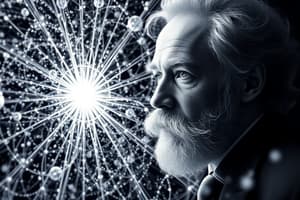Podcast
Questions and Answers
What does Planck's Radiation Law primarily explain?
What does Planck's Radiation Law primarily explain?
- The relationship between mass and energy.
- The continuous emission of energy from thermal sources.
- The relationship between an object's temperature and the energy it emits as electromagnetic radiation. (correct)
- The behavior of light as a wave.
Which of the following represents the concept of quanta in Planck's theory?
Which of the following represents the concept of quanta in Planck's theory?
- Energy can be converted without limits.
- Energy is emitted in a continuous stream.
- Energy is solely defined by its wavelength.
- Energy is emitted in discrete packets called photons. (correct)
What does the variable 'h' represent in the equation $E = hv$?
What does the variable 'h' represent in the equation $E = hv$?
- The speed of light.
- Frequency of the electromagnetic wave.
- Planck's constant. (correct)
- Total energy emitted.
What is the significance of Planck's constant in modern physics?
What is the significance of Planck's constant in modern physics?
Which advancement directly verified Planck's hypothesis?
Which advancement directly verified Planck's hypothesis?
What did Max Planck discover about the frequency of atomic vibrations?
What did Max Planck discover about the frequency of atomic vibrations?
What major concept did Paul Dirac introduce through his Dirac equation?
What major concept did Paul Dirac introduce through his Dirac equation?
Which of the following statements best describes the relationship between classical physics and quantum mechanics according to Dirac?
Which of the following statements best describes the relationship between classical physics and quantum mechanics according to Dirac?
What role did Planck's constant play in advancing physics?
What role did Planck's constant play in advancing physics?
Why was the appointment of Paul Dirac as Lucasian Professor of Mathematics significant?
Why was the appointment of Paul Dirac as Lucasian Professor of Mathematics significant?
What was the primary contribution of Max Planck to the field of physics?
What was the primary contribution of Max Planck to the field of physics?
Which significant work did Max Planck present in 1900?
Which significant work did Max Planck present in 1900?
What role did Max Planck play in the acceptance of Einstein's theories?
What role did Max Planck play in the acceptance of Einstein's theories?
What did Kirchhoff define in the context of black body radiation?
What did Kirchhoff define in the context of black body radiation?
At what age did Max Planck receive his doctoral degree?
At what age did Max Planck receive his doctoral degree?
What was a major challenge faced by physicists in the 1890s regarding light?
What was a major challenge faced by physicists in the 1890s regarding light?
What did Planck's studies on black body radiation reveal about classical thermodynamics?
What did Planck's studies on black body radiation reveal about classical thermodynamics?
Which university did Max Planck join as a professor in 1889?
Which university did Max Planck join as a professor in 1889?
Flashcards are hidden until you start studying
Study Notes
Planck's Quantum Theory
- Planck's theory revolutionized physics by proposing that energy is emitted in discrete packets called quanta or photons.
- A quantum is the smallest possible packet of energy.
Planck's Radiation Law
- Planck’s theory explains the relationship between an object’s temperature and the energy it emits as electromagnetic radiation.
Mathematical Equation
- Planck's theory can be described by the equation E = hv, where:
- E = Energy
- h = Planck’s constant
- v = Frequency
Quantized Energy
- Planck's theory proposed that light is composed of "quantized" energy packets, meaning that energy is not continuous, but comes in discrete packets.
Planck's Constant and Physical Units
- Planck's constant (h) is a fundamental constant in physics. It has allowed for the development of new physical units:
- Planck length: 1.6 x 10-35 meters (the smallest unit of length)
- Planck time: 5 x 10-43 seconds (the smallest measurable unit of time)
Verification and Extensions
- His hypothesis was later verified by Einstein, who used it to explain the photoelectric effect.
- The photoelectric effect demonstrates the existence of discrete energy packets or quanta during the transmission of light.
Impact and Significance
- Planck’s theory is considered a cornerstone of 20th-century science, paving the way for modern technologies like solar power.
- It’s one of two foundation stones of 20th-century science.
Milestones in Max Planck's Work
- Advanced his study of heat theory from 1885 to 1889 while associate professor of physics at Kiel University.
- Investigated black body radiation and calculated the vibration frequencies of atoms during the 1890s.
- Presented his radiation distribution law in 1900, introducing the concept of energy quanta to physics.
- Was one of the first prominent physicists to publicly support Einstein's Theory of Relativity.
- Received the Nobel Prize in Physics in 1919 for his groundbreaking discovery of energy quanta.
Planck's Early Life and Career
- Born in Kiel, Northern Germany.
- Showed aptitude for mechanics, mathematics, and music.
- Received a doctoral degree from the University of Munich at the age of 21.
- Became professor of theoretical physics at the University of Berlin, a role he held until his retirement in 1926.
Black Body Radiation
- In the 1890s, physicists struggled to explain the absorption and emission of light, becoming preoccupied with "black body" radiation.
- In 1859, Gustav Kirchhoff defined a black body as a hypothetical body that absorbs all electromagnetic radiation that falls on it.
- When heated, a black body radiates energy in the form of electromagnetic waves with a range of wavelengths.
- Experiments showed that the wavelengths radiated by hot objects did not match the predictions of classical thermodynamics.
- Planck attempted to align theory with observation.
Legacy and Further Work
- Planck popularized the work of his friend Albert Einstein in Germany in 1914.
- Created a new professorship for Einstein at the University of Berlin.
Paul Dirac
- Paul Dirac is best known for his Dirac equation, which predicted the existence of antimatter particles such as the positron.
- Dirac read Heisenberg's paper on matrix mechanics, which described how particles jump from one quantum state to another.
- Worked out a way to understand classical systems on a quantum level and created quantum field theory.
- His Dirac equation predicted antimatter particles or positrons, particles with identical properties to particles of matter but with the opposite electrical charge.
- Appointed Lucasian Professor of Mathematics at Cambridge University.
- Awarded the Nobel Prize in Physics in 1933 with Erwin Schrödinger.
Max Planck's Quantum Theory
- Max Planck refuted the ideas of classical physics.
- He showed that energy is emitted in fixed packets, or "quanta", fundamentally altering the way scientists interpreted the subatomic world.
Studying That Suits You
Use AI to generate personalized quizzes and flashcards to suit your learning preferences.





